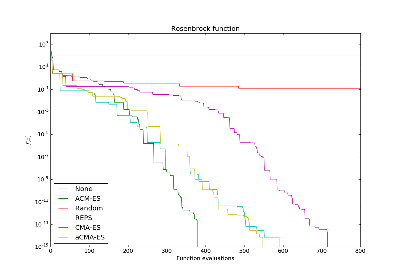Optimization¶
Optimization algorithms can be used for policy search directly or they can be used within a behavior search algorithm to optimize parameters internally. That is the reason why they play an important role in BOLeRo.
Optimizers seek to find some optimum (minimum or maximum) value, e.g. so that
where \(f\) is called objective function. In behavior learning, \(f\) is usually a fitness function or a reward function that has to be maximized. The library provides some black-box optimization algorithms. Black-box in this case means that no knowledge about the objective is required (e.g. gradients).
Optimizers¶
The following table gives an overview of the optimizers that are provided by BOLeRo.
| Optimizer name | Usecase |
|---|---|
| NoOptimizer | anything |
| RandomOptimizer | anything |
| CMAESOptimizer | 5 - 2000 parameters, ill-conditioned, non-separable, unimodal objective functions |
| IPOPCMAESOptimizer | 5 - 2000 parameters, ill-conditioned, non-separable, multimodal objective functions |
| BIPOPCMAESOptimizer | 5 - 2000 parameters, ill-conditioned, non-separable, multimodal objective functions |
| REPSOptimizer | 5 - 500 parameters, smooth objective functions |
| ACMESOptimizer | 5 - 150 parameters, ill-conditioned, non-separable, unimodal objective functions, more sample-efficient than standard CMA-ES |
No Optimizer¶
A NoOptimizer does not optimize at all. It can be used as a baseline
for optimizers.
Examples using bolero.optimizer.NoOptimizer¶
Random Optimizer¶
A RandomOptimizer explores the parameter space randomly. It can be
used as a baseline for optimizers.
CMA-ES¶
CMAESOptimizer implements the popular black-box optimizer
Covariance Matrix Adaption Evolution Strategy. It is a local optimizer although
it can be used to search for global optima with a large population size.
However, CMA-ES with a restart strategy like IPOPCMAESOptimizer or BIPOPCMAESOptimizer might work
better in this case.
The complexity of CMA-ES depends on the number of parameters \(N\) and is cubic \(O(N^3)\) because we approximate the covariance matrix of the parameter vector and compute its singular value decomposition. Hence, it should not be used with too many parameters.
CMA-ES represents its current solution by a Gaussian search distribution with mean \(\mu\) and covariance \(\sigma \boldsymbol{C}\) internally. During one iteration of the algorithm we will draw several samples from the distribution and compute their fitness. CMA-ES will order the samples and compute their weights for the next update based on their rank. That is the reason why CMA-ES is robust to rank-preserving transformations of the objective function.
The optimization procedure is displayed in the following figure. Each image displays one generation of samples. Each generation is sampled from the same search distribution. The old search distribution is displayed by an orange equiprobable ellipse and the updated search distribution is displayed by a green ellipse.
ACM-ES¶
ACMESOptimizer is CMA-ES with a surrogate model. The surrogate model
is a ranking SVM that tries to predict the rank of samples locally. This
improves sample efficiency but also increases computational demand of the
optimization algorithm. If an episode has a high cost, it will make sense
to prefer this variant of CMA-ES.
IPOP-CMA-ES¶
CMA-ES is a local optimizer. It cannot escape local minima. Hence, to turn it
into a global optimizer, we have to restart the optimization process when it
gets stuck until we find a global optimum. One restart strategy is implemented
by IPOPCMAESOptimizer. IPOP-CMA-ES doubles the population size after
each restart.
BIPOP-CMA-ES¶
Another restart strategy is implemented by BIPOPCMAESOptimizer.
BIPOP-CMA-ES can decide whether it makes more sense to decrease or increase
the population size.
REPS¶
REPSOptimizer is an episodic policy search algorithm that can be used
like a black-box optimizer. The search distribution is a multivariate Gaussian.
REPS constrains the updates of the search distribution by bounding the KL
divergence between successive search distributions.
Contextual Optimizers¶
The following table gives an overview of the contextual optimizers that are provided by BOLeRo.
| Optimizer name | Usecase |
|---|---|
| CREPSOptimizer | 5 - 500 parameters and 1 - 5 context dimensions |
| CCMAESOptimizer | 5 - 500 parameters and 1 - 5 context dimensions |
C-REPS Optimizer¶
The CREPSOptimizer implements the algorithm Contextual Relative
Entropy Policy Search which is a state of the art approach for contextual
optimization. It represents the upper-level policy by a linear model with
nonlinear features from the context. It guarantees that the Kullback-Leibler
divergence between successive policy distributions is bounded so that
potentially dangerous exploration can be controlled.
The first publication that describes C-REPS is
See also
Kupcsik, Deisenroth, Peters, Neumann: Data-Efficient Generalization of Robot Skills with Contextual Policy Search. http://www.ausy.informatik.tu-darmstadt.de/uploads/Publications/Kupcsik_AAAI_2013.pdf
A more detailed description of C-REPS and this implementation can be found in the appendix of
See also
Fabisch, Metzen: Active Contextual Policy Search. http://jmlr.org/papers/v15/fabisch14a.html
C-CMA-ES Optimizer¶
CCMAESOptimizer is an extension of CMA-ES to the contextual
optimization domain. It works better than C-REPS for problems where the
step size has to be adapted quickly because the step size adaptation is
not bounded by the KL divergence like in C-REPS.

